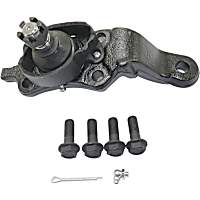When it comes to car parts, control arms don’t get a lot of attention. Instead, it’s all about engines and transmissions. You know, the big, expensive stuff. But control arms are important, too. And they can be a real bear to replace if they’re rusted or seized in place.
For example, I recently had to replace the electric power steering rack in my car—a job that involves removing the subframe. I figured that, while I was at it, I would replace the control arms since their bushings were worn.
Yeah, easier said than done. When I went to remove the first arm, the mounting bolt spun around in circles but did not back out. At the same time, the twisting motion from my impact wrench turned the bushing into a pretzel. It didn’t take me long to realize the bolt was fused to the sleeve inside the bushing.
Thankfully, it was possible to cut both the sleeve and the bolt out of the subframe. That freed up the control arm and allowed me to replace it.
Why am I telling you this? Because it helps to have a sense of appreciation for humble control arms. Even though they might seem simple, after several years of rust and corrosion buildup, they can be challenging to replace.


You May Have a Faulty Control Arm If…
Control arms rarely fail unless they’ve been subjected to impact damage during, say, a collision. Instead, bushings and ball joints, which are built into the control arm, are the components that tend to wear out.
These days, it’s often more efficient to replace the entire control arm instead of a bushing or ball joint. Also, on some cars, the bushings and joints are non-serviceable, meaning the entire control arm must be replaced.
Clunking Noise
Worn control arm bushings or ball joints can cause a clunking noise that’s heard while traveling over bumps. In some instances, faulty control arm bushings may make a banging or clunking noise under hard acceleration or braking as well.
Pulling to One Side
A bent control arm, worn control arm bushing, or faulty ball joint can throw off your car’s alignment. As a result, you might feel a pulling sensation while traveling down the road.
Uneven Tire Wear
Because control arm issues can alter a car’s alignment, they can also lead to uneven tire wear.
Abnormal Steering Response
Worn ball joints or control arm bushings can allow the steering knuckle to exhibit abnormal movement. Consequently, you may experience vague steering or feel a shimmy-type sensation through the steering wheel.

What Does a Control Arm Do?
Most modern cars have at least two control arms—one behind each front wheel. Some vehicles have control arms at all four corners. Depending on the suspension design, there may be both upper and lower control arms, or just lower control arms. Front control arms connect to the vehicle’s frame at one end, and the steering knuckle at the other end.
The control arm’s purpose is two-fold: first, it’s designed to allow the car’s wheel and tire assembly to move up and down while traveling over bumps. At the same time, the control arm limits the movement of certain steering and suspension components (hence the name, “control arm”).
All control arms have bushings, which allow the control arm to move up and down freely without binding in the frame. Each bushing contains a rubber center portion and an inner metal sleeve. In many cases, a bolt slides through the sleeve to secure the control arm to the frame.
Each front control arm also has a built-in ball joint. The ball joint allows the steering knuckle to pivot when the driver turns the steering wheel.
What to Do If You Think You Have a Faulty Control Arm
Typically, the control arm itself only fails as a result of impact damage. When the control arm requires replacement, it’s usually because the bushings and/or ball joints are worn. And vehicle safety can be compromised if the bushings or joints fail.
So, if you’ve got a control arm in need of replacement, get it taken care of immediately. A wheel alignment will also need to be performed after the control arm is replaced.
Watch these videos to get an idea how to replace your control arm:
Where to Get Control Arms for Your Vehicle
Shopping for a new control arm can be stressful and overwhelming. Thankfully, ordering from CarParts.com makes it easier to find a high-quality replacement that fits and functions like the stock part.
Browsing our catalog of auto parts is convenient thanks to our user-friendly website. From checking for vehicle fitment to placing your order through our secure payment channels–the parts you need are just a few clicks away. Simply input your vehicle’s year, make, and model to browse the products that match your vehicle’s specifications.
Get your order delivered straight to your doorstep in a matter of days. Our distribution centers are equipped with the latest technology to ensure a swift and efficient delivery process.
Get your vehicle back on the road in no time. Order a replacement control arm from CarParts.com today!
Products Mentioned in this Guide
Any information provided on this Website is for informational purposes only and is not intended to replace consultation with a professional mechanic. The accuracy and timeliness of the information may change from the time of publication.


 Control Arm
Control Arm
 Ball Joint
Ball Joint
 Control Arm Bushing
Control Arm Bushing
















how do i replace an upper control arm in my 1985 chevy pickup
how do i replace a upper control arm in my 1985 chevy pickup
What is the problem when I accelerate hard and let off the gas and my 61 Comet pulls to the left for a second.
Ron